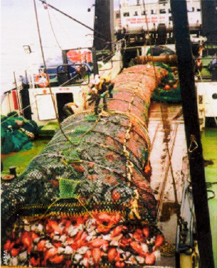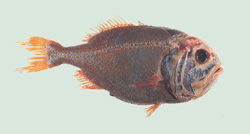|
|

Rough seas for orange roughy:
Popular U.S. fish import in jeopardy
World Wildlife Fund Release
WASHINGTON 30 December 2003
Reckless overfishing is rapidly causing the demise of orange roughy and other imported
fish species popular with U.S. consumers, according to a new scientific study released
by the World Wildlife Fund (WWF) and TRAFFIC. The study finds that rapidly expanding and
unregulated fishing in deep waters is fast depleting species that could become commercially
extinct if protective measures are not taken immediately by international governing bodies.
"The report shows that some deep ocean fish stocks, like orange roughy, have been wiped
out in less than four years," said Simon Habel, director of TRAFFIC-North America, the
wildlife trade-monitoring network.
"As Americans buy more and more orange roughy, they contribute to the pressures that could
ultimately take the fish right off their plates and out of the seas as well." The
United States is a significant and growing market for orange roughy, importing more than
19 million pounds annually in recent years and accounting for nearly 90 percent of
documented catches.
|
 |
A rising demand for seafood, and severe depletion of fish stocks closer
to shore, has led to the rapid expansion of deepsea fisheries and subsequent damage to
sensitive marine areas, especially seamounts, where many species new to science could
soon face extinction before even being identified. |
 A haul of orange roughy. Photo AFMA A haul of orange roughy. Photo AFMA
|
|
"We are calling for urgent and strong protection measures to protect orange roughy
populations and particularly sensitive marine areas such as seamounts," said Kim Davis,
deputy director of WWF's Marine Conservation Program.
"Unchecked growth of fishing fleets and ineffective fleet monitoring have been especially
damaging to orange roughy fisheries and deepsea resources in New Zealand, Australia, the
Southern Indian Ocean, and the Northeast Atlantic Ocean. These are basic failures
of management that must be reversed if we are to ensure the survival and the commercial
viability of these species"
Additional problems identified in the report include poor understanding of biological
characteristics of the species, inadequate stock assessment models a lack of political
will needed to impose rigorous management decisions and the failure to support management
decisions that are implemented with effective monitoring, control and surveillance measures.
"The report reveals that orange roughy fisheries have been managed poorly, or not managed
at all," added Davis. "This research provides valuable lessons for the future development
of deepsea fisheries. It shows that we must learn from our mistakes - and explore, not
destroy, the resources of our last frontier." |
|


|
Orange roughy predominantly live around the deep ocean seamounts which are underwater
mountains, and plateaus just off the continental shelf, at depths from 500 to 1,500
metres.
If not caught, orange roughy have one of the longest lives of all marine species -
perhaps more than 150 years. It has the capacity to school in millions around
seamounts, especially during feeding and spawning when they are targeted by fishers.
It is thought that orange roughy mature and start reproducing between 20 and 40 years
of age. They have a low fecundity and produce low egg counts compared to other
fish.
They grow to a length of 60 cm and weigh up to 3.5 kg, but are commonly
caught when they are 35-45 cm long and weigh between 0.8 and 1.5 kg.
Long living deepsea fish are slow to recover from exploitation. Generally,
deepsea species are depleted more rapidly and recover more slowly, if at all, than
inshore fish. |
|
|
Orange roughy have firm flesh that produces a white, boneless fillet that is
amenable to freezing, and have proven quite popular with United States consumers.
Once commonly known as slimeheads, orange roughy (Hoplostethus atlanticus) were
renamed by New Zealanders to reflect the bright orange color and rough scales of the
fish, and to sound more palatable to consumers.
According to the WWF report, the United States is the main importer of orange roughy.
New Zealand is the main supplier, providing more than 60 percent of United States imports
in 2002, followed by China (18 percent) and Australia (17 percent).
Namibia was a major supplier, experiencing rapid expansion of its fishery and accounting
for nearly one-third of United States imports in the mid-1990's. Later, that same
fishery declined rapidly and Namibia accounted for only 2 percent of United States imports
in 2002.
|
|
|
 |
|



















 A haul of orange roughy. Photo AFMA
A haul of orange roughy. Photo AFMA See the complete WWF report
See the complete WWF report 